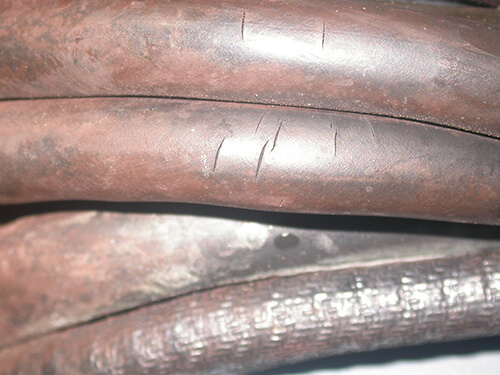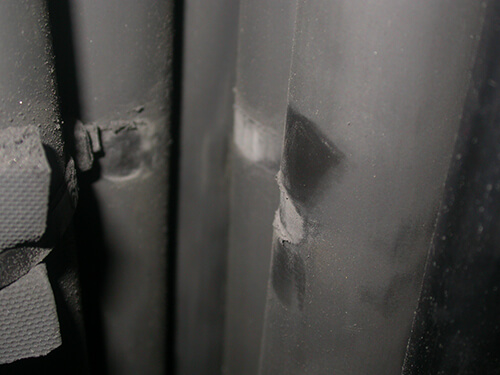
By James Moorman, Vice President of Sales
Legacy fleets that are operating today and approaching the end of their service life will be analyzed by asset owners and technicians on whether these aging turbines can be overhauled to continue operating or be decommissioned. For wind farm operators who decide to overhaul and repower their existing machines, re-using their existing infrastructure is a possibility as long as the components that are put into the existing towers are compliant with the current standards.

Cables that have been exposed to oil and other lubricants for long periods can begin to crack as the plasticizers have been removed from the insulation causing it to harden.
Meeting Today’s Standards for Wind Turbines
Underwriters Laboratories (UL) standards 6141 and 6142, which were enacted in 2016/2017, aim to simplify the process of receiving final approval for wind turbines through local Authorities Having Jurisdiction (AHJ) inspectors. In the US, local AHJs need to certify that products are safe to use in accordance with general American installation regulations such as the National Electric Code (NEC), National Electrical Safety Code (NESC) and American National Standards Institute (ANSI)/ Institute of Electrical and Electronics Engineers (IEEE) C2, among others. It is not always clear whether components that originally complied with the European CE standards also comply with American installation regulations. If there is any doubt, an AHJ inspector may shut down the project. UL 6141 and UL 6142 are the first American safety standards developed specifically for wind turbines. They provide a set of rules that help AHJ inspectors with the approval process, making it more transparent and predictable for everyone involved.

Cables used in the drip loop that have low abrasion resistance often show wear due to the constant rubbing that occurs as the nacelle rotates. Over time, abrasion can wear down the jacket and insulation exposing the conductor and creating risk to technicians and the machine. It’s important to use cables with high abrasion resistance to maximize their longevity in this critical area of the turbine.
UL Aims to Harmonize with IEC 61400
For many years there were no national safety standards specifically for wind turbines in North America. The only guidelines AHJs had for reference was IEC 61400, which is the international standard for wind turbines issued by the International Electrical Commission (IEC). However, the IEC standard has been criticized in North America since it was published. Critics claimed that it did not include enough provisions regarding the electrical safety of components, controls and protection devices.
Therefore, UL developed national standards to supplement IEC 61400. These standards refer directly to IEC 61400-1 (Design Requirements) and IEC 61400-2 (Small Wind Turbines), and add technical requirements primarily focused on electrical safety, control, safety devices and fire protection within the wind turbine. These UL standards – 6141 and 6142 – thereby bridged the gap between the IEC standards.
ANSI issued UL 6141 as an American National Standard for Wind Turbines Permitting Entry of Personnel. UL 6141 applies to large-scale wind turbines, typically 1MW and above, that can or may be entered by operators or service technicians for operation or maintenance.
UL 6142 has been acknowledged as a national standard for small wind turbine systems by ANSI since it was first proposed in 2012. It applies to smaller, commercial-kW wind turbines that are found closer to residential areas, and typically have a nominal capacity of up to 1,500 V AC. Due to their size, most smaller turbines aren’t large enough for operators/technicians to enter inside to perform maintenance or inspections, so they are either hinged to be laid down or climbed externally. There are smaller turbine types that are large enough to be entered and climbed by a tech, but are still classified as a “small turbine”. For these turbines, there are lock-out/tag-out procedures for operators and technicians to enter the turbine to perform maintenance.
Both UL standards apply exclusively to on-shore wind turbines and only affect new constructions or the refurbishing of wind turbines with a capacity greater than 500 kW. Existing legacy fleet systems do not need to be refitted to meet the UL standards until their end of service life date comes due.

The power and data cables within the tower should also be inspected and replaced, if needed, during the retrofit.
How Does UL 6141 Impact the Use of Cables?
UL 6141 focuses primarily on electrical safety and introduces several restrictions on how cables may be used in the future. The bottom line is that appliance wiring material (AWM) – in other words, cable that is UL Recognized but is not UL Listed – may only be used minimally within the turbine. Up until now, AWM cables were frequently used throughout the various sections of the wind turbines. UL 6141 stipulates that all accessible cables need to be installed in cable ducts or trays. If this is impractical or impossible, e.g. in the cable loop, only so-called tray-rated cables, more specifically cables that are approved for exposed run (TC-ER), are allowed. The -ER or “exposed run” approval allows cable to come out of the cable tray unprotected for ≤6 ft. (1.8m) if it passes crush and impact tests. Cables in the down tower and nacelle are usually accessible and therefore must be certified for exposed run as well.
Tray cables that are designed to be used for exposed run applications are oil and flame resistant, and fulfill the increased safety requirements of UL 6141. In fact, cables need to be UL Listed to be classified as tray cable. Tray cable rated for 600 V falls under UL 1277 (Electrical Power & Control Tray Cable), while wind turbine tray cables (WTTC), which are rated up to 1000 V, are listed under UL 2277 (Flexible Motor Supply Cable and Wind Turbine Tray Cable). Unlisted AWM cables have not passed the specified tests and therefore are not suitable for exposed run applications. UL standards were already in place to regulate components in certain wind turbine subsystems such as generators. These standards will continue to apply. Furthermore, UL 6141 will apply to areas that were not previously regulated by a standard.


The cables replaced during an overhaul can vary based on what equipment is being upgraded or repaired. With thousands of components in an entire turbine, a majority of the cables replaced are located in the nacelle, and the drip loop, where cables experience millions of torsion cycles over their lifespan.
Sponsored content by Helukabel
Filed Under: Sponsored Content




